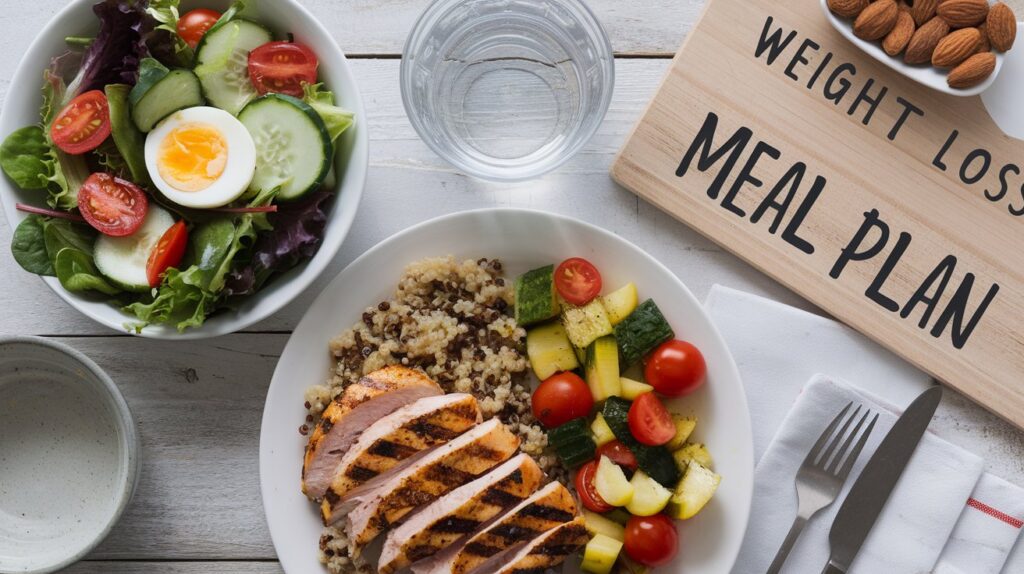Losing weight isn’t just about hitting the gym or cutting out certain foods—it’s about having a plan that works for your lifestyle. A weight loss meal plan can be the game-changer you need to stay on track, reduce stress, and see sustainable results.

In this article, we’ll explore everything you need to know about weight loss meal plans, from creating one tailored to your goals to providing a sample 7-day plan that takes the guesswork out of eating healthy. Let’s dive in!
What is a Weight Loss Meal Plan?
Definition and Purpose
A weight loss meal plan is a structured eating schedule designed to help you achieve your weight loss goals by focusing on balanced nutrition and portion control. The purpose is simple: to ensure you’re consuming fewer calories than you burn, all while getting the nutrients your body needs to thrive.
Key Principles of a Successful Meal Plan
Caloric Deficit: To lose weight, you need to consume fewer calories than you expend. Calculating this deficit is the cornerstone of any effective plan.
Macronutrient Balance: A good plan includes a mix of protein (for muscle preservation), healthy fats (for energy), and carbs (for fueling activities).
Whole Foods Focus: Emphasizing fresh, unprocessed ingredients keeps you full and supports overall health.
Benefits of Following a Weight Loss Meal Plan
Portion Control and Calorie Management
One of the biggest challenges in weight loss is keeping calorie intake in check. A well-designed meal plan helps you manage portion sizes and ensures that you’re not overeating. By pre-planning meals and snacks, you can avoid mindless grazing or impulsive decisions that often lead to excessive calorie consumption.
Tracking your calories becomes much easier with a meal plan, as you already know what and how much you’ll eat. This level of control is essential for staying within your daily caloric limit and achieving consistent weight loss results.
Saving Time and Reducing Stress
Imagine this: no more last-minute trips to fast food joints or aimlessly staring into your fridge wondering what to eat. Meal planning simplifies your life by removing the guesswork. When you prepare your meals in advance, you save valuable time during busy weekdays and reduce the stress of making quick, unhealthy food choices.
Moreover, meal planning helps with grocery shopping. With a clear list of what you need, you’ll spend less time wandering the aisles and avoid buying unnecessary items that may derail your progress.
Supporting Sustainable Weight Loss
Fad diets often lead to short-term results, followed by weight regain. A structured meal plan, on the other hand, encourages sustainable eating habits that you can maintain long-term. By creating balanced meals and sticking to a routine, you’re more likely to keep the weight off for good.
How to Create a Weight Loss Meal Plan
Setting Goals and Calculating Caloric Needs
Before diving into meal planning, it’s crucial to define your weight loss goals. How much weight do you want to lose, and by when? Once you have a goal in mind, calculate your daily caloric needs using a weight loss calculator or a simple formula like the Harris-Benedict Equation.
Your caloric target should create a deficit of 500–750 calories per day, which typically results in a safe and sustainable weight loss of 1–2 pounds per week.
Choosing the Right Foods
The foundation of any successful weight loss meal plan is the quality of the foods you eat. Focus on nutrient-dense options that fuel your body and keep you satisfied:
- Lean Proteins: Chicken, turkey, fish, tofu, eggs, and legumes.
- Complex Carbs: Brown rice, quinoa, sweet potatoes, and whole-grain bread.
- Healthy Fats: Avocado, nuts, seeds, olive oil, and fatty fish like salmon.
- Fruits and Vegetables: A colorful variety to provide essential vitamins and minerals.
Meal Timing and Frequency
How often you eat can affect your energy levels and hunger throughout the day. While some people thrive on three main meals, others prefer smaller, more frequent meals. Consider your schedule and preferences when planning your meals.
Some individuals also explore intermittent fasting, where eating is restricted to a specific time window. This can be an effective strategy for those who find it helps control their appetite and calorie intake.
Sample Weight Loss Meal Plan
7-Day Meal Plan for Weight Loss
Here’s a simple, balanced 7-day meal plan to kick-start your weight loss journey:
Day 1
- Breakfast: Greek yogurt with mixed berries and a drizzle of honey.
- Snack: A handful of almonds.
- Lunch: Grilled chicken salad with mixed greens, cucumbers, and olive oil vinaigrette.
- Snack: Baby carrots with hummus.
- Dinner: Baked salmon with quinoa and steamed broccoli.
Day 2
- Breakfast: Scrambled eggs with spinach and whole-grain toast.
- Snack: Apple slices with peanut butter.
- Lunch: Turkey and avocado wrap with a side of cherry tomatoes.
- Snack: Cottage cheese with pineapple chunks.
- Dinner: Stir-fried tofu with mixed vegetables and brown rice.
Vegetarian and Vegan Meal Plan Options
For vegetarians and vegans, it’s important to focus on plant-based protein sources and nutrient-rich options:
- Breakfast: Oatmeal topped with chia seeds, almond butter, and banana slices.
- Lunch: Lentil soup with a side of whole-grain bread.
- Dinner: Grilled portobello mushroom with quinoa and sautéed spinach.
Tips for Sticking to Your Meal Plan
Meal Prepping and Cooking Strategies
Meal prep is the secret to staying on track. Dedicate a day each week to prepare your meals in bulk. Use portioned containers to store them for easy grab-and-go options throughout the week. Slow cookers, air fryers, and food processors can make meal prep quicker and more enjoyable.
Managing Cravings and Emotional Eating
Cravings can derail your progress, but they don’t have to! Combat cravings by keeping healthy snacks on hand and staying hydrated. If emotional eating is a challenge, try journaling, meditating, or calling a friend instead of turning to food for comfort.
Staying Hydrated and Tracking Progress
Water is your best friend in weight loss. Not only does it keep you hydrated, but it also helps curb hunger. Aim for at least 8–10 glasses a day. Additionally, track your progress using a journal or app to stay motivated and identify areas for improvement.
Conclusion
A weight loss meal plan is your roadmap to success. By focusing on balanced nutrition, portion control, and sustainability, you can shed pounds and build healthy habits that last a lifetime. Remember, weight loss is a marathon, not a sprint—commit to the process and celebrate every step of progress along the way.
FAQs
1. What is the best calorie range for a weight loss meal plan?
The ideal range depends on your current weight, activity level, and goals. A typical range for weight loss is 1,200–1,800 calories per day, but it’s important to customize based on your needs.
2. Can I include desserts in my meal plan?
Yes, in moderation! Opt for healthier dessert options like dark chocolate, fruit parfaits, or baked goods made with whole-grain flour and natural sweeteners.
3. How often should I update my weight loss meal plan?
It’s a good idea to revisit your plan every 2–4 weeks. As your weight changes, your caloric needs will too, and adjusting ensures continued progress.
4. What should I do if I hit a weight loss plateau?
Plateaus are common. To overcome them, try adjusting your calorie intake, increasing exercise intensity, or changing up your meal composition.
5. Is it necessary to track every calorie for success?
Not necessarily. While tracking calories can help in the beginning, focusing on balanced meals and portion control is often sufficient for long-term success.










